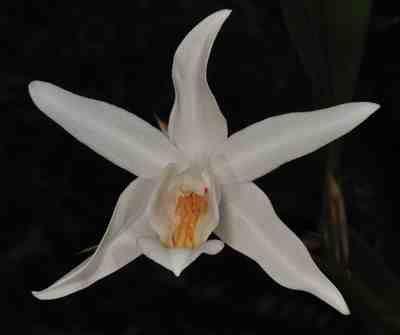Epiphyte. Leaves coriaceous, obtuse, fleshy, linear-oblong, slightly notched at the apex with the base expanded than the apex, long, up to 40 to 50 cm and 2 to 4 cm in width. Inflorescence from the base of the pseudo-stem, variable in length, between 35 to 60 cm long. The peduncle with several acute scarious sheaths near the base. Raceme with many flowers. Flowers 2 to 3 cm across. Sepals and petals yellowish orange with petals slightly brighter than the sepals. Both with a radiating purple stripe, notably wider on petals than sepals. Lip white with purple parallel stripes on its base. Sepals narrowed, sub-equal, oblong, slightly oblanceolate, blunt, dorsal erect and lateral pairs somewhat falcate. Petals shorter than the sepals, ovate-oblanceolate, blunt. Lip as long as the sepals, oblong, disc with two broken lamellae and disconnected in the middle; apical lobe much decurved.

The Pursuit
This species is purely a native to tropical valleys, also observed growing up to 3500 ft in some areas. My flower hunts on the Eastern side of the region, especially on the Assam highway helped me to notice this species growing in abundance on trees inside a few Tea estates. Also, in the monumental book of Sir. George King and Robert Pantling, the habitat is mentioned as “low elevations”. My desire to get the perfect descriptions of them by the authors, made me concentrate on the plants of that area which was around 300 to 450 ft altitude only. That place was around 70 km away from my place of stay, and also the temperature rises up to 37C during the mid-day hours (in the Himalayas the rising temperature is my enemy!!!!). When ever I do my survey on those areas I start my day very early, so that the survey of that area can be done well before the sun climbs right above my head. Got information from the local friends that a lot of plants are in bloom and went there in the early hours. The drive will take around 3 hours. On that day, I was forced to climb up some trees to look for another species, so the drive took for more time to reach. It was true, that a lot of trees were bearing this flowers in plenty. As it was in a Tea estate where there are a lot of workers, helping hands are of no scarcity. I found a very good plant at around 8 ft from ground with pendulous flowers hanging right in front of my eye level. The enthusiastic workers around were helping me by holding flashes from various sides to produce this wonderful photograph. It seemed all of the workers want to be part of this monumental work. The Manager of the Tea estate invited me for lunch and returned by late afternoon only. While working in the hills where comfort is at its minimum, a meal like that will always keep one happy.








